
Accommodation > Tours
Seoul City Tour Bus

About the Seoul City Tour Bus
The Seoul City Tour Bus offers organized shuttle tours of the city’s most popular and noteworthy attractions through circular routes. With one ticket valid for the day, tourists may hop-on and hop-off at any of its destinations to visit the attractions of their choice (except for the nighttime tours which are non-stop).

Information

- Please Note:
- Each bus tour returns to the point of departure then repeats the same course.
- The Nighttime tours are non-stop and there are no stops in-between.
- *The Cheonggyecheon/Royal Palaces tour runs from 10 a.m. during the months of March, June, September, and November. All other months the tours begin at 9 a.m.
- The Cheonggyecheon/Royal Palaces tour does not stop by Deoksugung and Chenggye Square on Saturday afternoons after 2 p.m., holidays, and on occasions when the routes may be closed.
- The City Circulation course departs every twenty minutes during the summer peak season.
- Where to Purchase Tickets
- Purchase from guide on a City Tour bus
- Ticket Booth next to Koreana Hotel at Gwanghwamun (02-777-6090)
- Ticket office in front of Doosan Tower in Dongdaemun (1544-4239)
- Payment
- You may buy tickets directly by cash from the on-board guide at any of the City Bus Tours if and when there are seats available.
- You must purchase the tickets at the Gwanghwamun ticket booth if you wish to pay with a credit card.
- You may purchase a ticket through the on-board guide with cash or credit card at any stops for the Traditional Markets course.
- How to Get to the Main Ticket Booth
-
1) To the Ticket Booth next to Koreana Hotel at Gwanghwamun
It takes 20 minutes by taxi and costs around KRW 7,000 (approx. USD 6), depending on the traffic.
2) To the Ticket office in front of Doosan Tower in Dongdaemun
It takes 35 minutes by taxi and costs around KRW 11,000 (approx. USD 10), depending on the traffic.
-
1) To the Ticket Booth next to Koreana Hotel at Gwanghwamun
It takes 15 minutes by taxi and costs around KRW 5,300 (approx. USD 5), depending on the traffic.
2) To the Ticket office in front of Doosan Tower in Dongdaemun
It takes 25 minutes by taxi and costs around KRW 8,600 (approx. USD 8), depending on the traffic.
Site Information
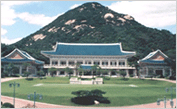 |
Presidential Blue House
The symbol of Cheongwadae (known to westerners as the Blue House or the presidential residence), is the blue tiles. The first thing that catches your eye when you arrive at Cheongwadae is the blue tiles of the main building. The blue tiles and the smooth roof are in beautiful harmony with Mt. Bugaksan behind it. As the Blue House represents Korea, the blue tiles and the smooth curve of the roof represents the beauty of Korea.
|
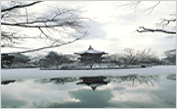 |
Royal Palace (Gyeongbok Palace)
Gyeongbokgung, also known as Gyeongbokgung Palace or Gyeongbok Palace, is a royal palace located in northern Seoul, South Korea. First constructed in 1394 and reconstructed in 1867, it was the main and largest palace of the Five Grand Palaces built by the Joseon Dynasty. The name of the palace, Gyeongbokgung, translates in English as "Palace of Shining Happiness.
|
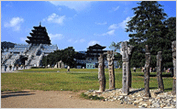 |
The National Folk Museum of Korea
The National Folk Museum of Korea displays the culture and folk history of the Korean people from prehistoric times to the end of the Joseon Dynasty. The museum is situated in the precinct of Gyeongbokgung (Palace) which is a typical palace of the Joseon Dynasty. It holds a variety of seasonal exhibitions and events each year alongside a permanent exhibition. Each year more than two million visitors come to visit and explore the roots of the Korean life style.
|
 |
Namdaemun Market
Namdaemun Market is the largest traditional market in Korea with over 10,000 stores that line the streets around Namdaemun (Gate), the main southern gate of the old city wall. It boasts one of the largest distribution structures in Korea, providing local products, daily living essentials, food products, medical supplies and more to retailers and consumers across the country. Due to the wholesale nature of the market, shoppers can comparison shop for the lowest prices on all sorts of goods. Namdaemun Market is also packed with interesting things to see and eat, making it a popular destination for both locals and international visitors alike.
|
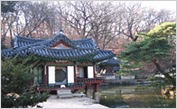 |
Changdeok Palace
Changdeokgung, also known as Changdeokgung Palace or Changdeok Palace, is set within a large park in Jongno-gu, Seoul, South Korea. It is one of the "Five Grand Palaces" built by the kings of the Joseon Dynasty. Because of its location east of Gyeongbok Palace, Changdeokgung, with Changgyeonggung, is also referred to as the East Palace. The literal meaning of Changdeokgungis "Palace of Prospering Virtue". Changdeokgung was added to the UNESCO World Heritage List as being an outstanding example of Far Eastern palace architecture and garden design, exceptional for the way in which the buildings are integrated into and harmonized with the landscape.
|
 |
Insadong Street
The streets of Insadong are alive with traditional culture. The area that is now known as Insadong has been the center of culture since the Joseon era. Over the years a wider variety of arts have continued to move their way into this neighborhood making it one of the best places in the world to find diverse genres of art. In 1997, car traffic was banned on the main street of Insadong making it friendlier for visitors and improving the overall general atmosphere.
|
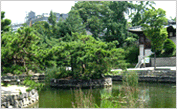 |
Namsangol Hanok Village
Namsangol Hanok Village is a collection of five hanoks (traditional Korean houses) from the Joseon Dynasty (1392-1910), recovered from different parts of the city and relocated to the northern foot of Namsan mountain. The interiors of each of these five houses reflect owners from different walks of life, from the middle class to the yangban (who were mainly high government officials, noblemen and aristocrats).
|
 |
N Seoul Tower
N Seoul Tower was built in 1969 as Korea’s first integrated transmission tower beaming television and radio broadcasts across the capital. Since opening to the public in 1980, it has become a much-loved Seoul landmark. The tower’s main attractions include multi-colored digital art projected onto the tower at night, a digital observatory, a roof terrace, the HanCook restaurant, the n.Grill restaurant, and the Haneul (Sky) Restroom. N Seoul Tower’s mountain surroundings on Namsan (Mt.) have made it a popular place to unwind for locals and tourists alike.
|
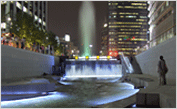 |
Cheonggyecheon
Cheonggyecheon is an 11 km long modern stream that runs through downtown Seoul. Created as part of an urban renewal project, Cheonggyecheon is a restoration of the stream that was once there before during the Joseon Dynasty (1392-1910). The stream was covered with an elevated highway after the Korean War (1950-1953), as part of the country's post-war economic development. Then in 2003, the elevated highway was removed to restore the stream to its present form today. The stream starts from Cheonggye Plaza, a popular cultural arts venue, and passes under a total of 22 bridges before flowing into the Hangang (River), with many attractions along its length.
|
















